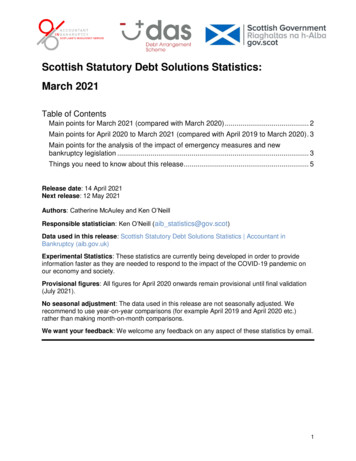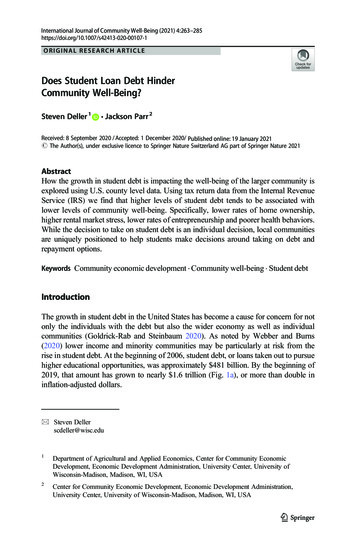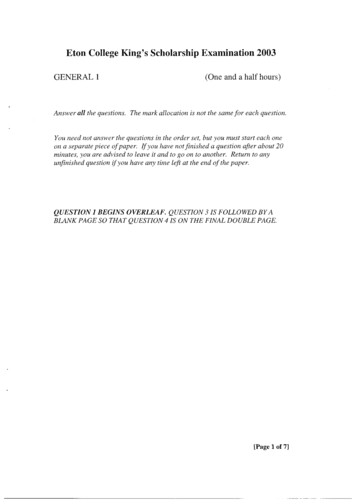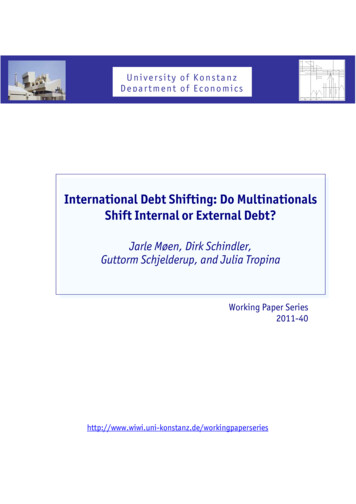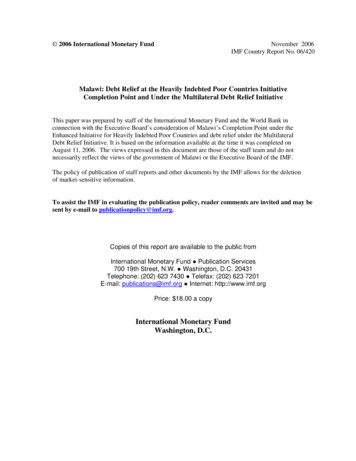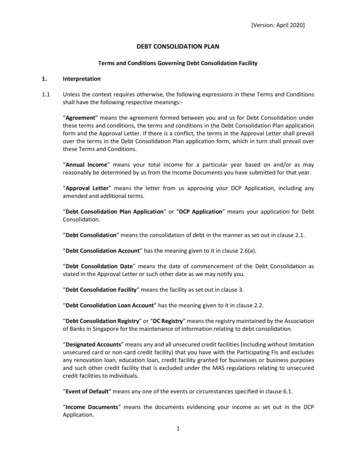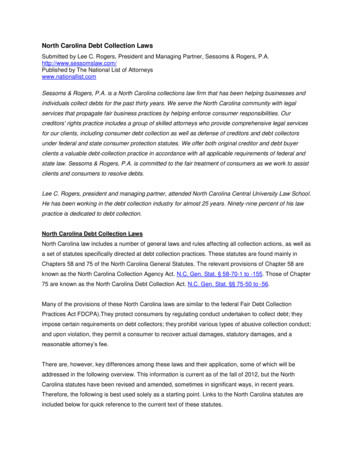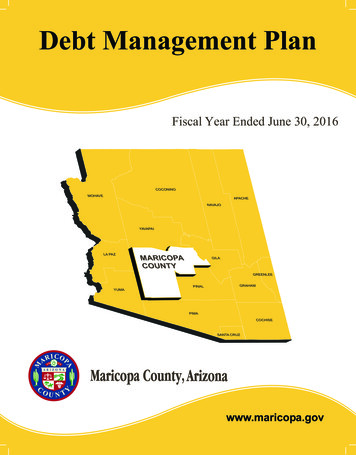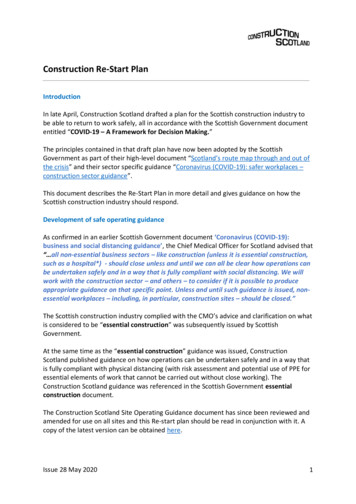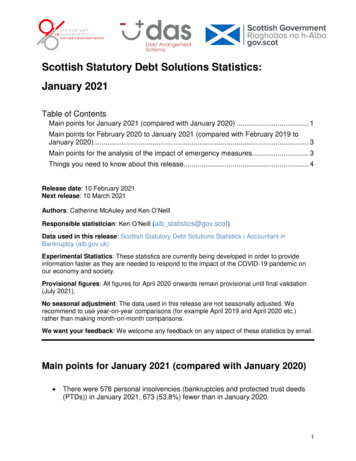
Transcription
Scottish Statutory Debt Solutions Statistics:January 2021Table of ContentsMain points for January 2021 (compared with January 2020) . 1Main points for February 2020 to January 2021 (compared with February 2019 toJanuary 2020) . 3Main points for the analysis of the impact of emergency measures. 3Things you need to know about this release . 4Release date: 10 February 2021Next release: 10 March 2021Authors: Catherine McAuley and Ken O’NeillResponsible statistician: Ken O’Neill (aib statistics@gov.scot)Data used in this release: Scottish Statutory Debt Solutions Statistics Accountant inBankruptcy (aib.gov.uk)Experimental Statistics: These statistics are currently being developed in order to provideinformation faster as they are needed to respond to the impact of the COVID-19 pandemic onour economy and society.Provisional figures: All figures for April 2020 onwards remain provisional until final validation(July 2021).No seasonal adjustment: The data used in this release are not seasonally adjusted. Werecommend to use year-on-year comparisons (for example April 2019 and April 2020 etc.)rather than making month-on-month comparisons.We want your feedback: We welcome any feedback on any aspect of these statistics by email.Main points for January 2021 (compared with January 2020) There were 578 personal insolvencies (bankruptcies and protected trust deeds(PTDs)) in January 2021, 673 (53.8%) fewer than in January 2020.1
Bankruptcies decreased by 62.6% in January 2021 when compared with January2020.(It is important to note that these provisional results will not be finalised until finalvalidation. The late reporting of creditor petitions, in particular, may lead todifferences between first provisional estimates and actual finalised figures.) PTDs decreased by 50.2% over the same period. There were 246 approved Debt Payment Programmes (DPPs) under the DebtArrangement Scheme in January 2021 compared with 274 in January 2020, adecrease of 10.2%.2
Main points for February 2020 to January 2021 (comparedwith February 2019 to January 2020) All main points within this section are presented on a 12-month rolling basis. There were 8,412 personal insolvencies in the 12 months to January 2021(inclusive), 5,289 (38.6%) fewer than in the previous 12 months. Bankruptcies decreased by 44.3% in the 12 months to January 2021 whencompared with the previous 12 months. PTDs decreased by 35.5% over the same period. There were 3,425 approved DPPs under the Debt Arrangement Scheme in the12 months to January 2021 compared with 2,980 for the previous 12 months, anincrease of 14.9%.Main points for the analysis of the impact of emergencymeasuresThe introduction of new provisions on the statutory moratorium and the revised feestructures in place for accessing bankruptcy are part of emergency measuresbrought in by both the Coronavirus (Scotland) Act 2020 and the Coronavirus(Scotland) (No.2) Act 2020: As at 31 January 2021, 1,426 applications for moratoria had been granted underthe new powers. There were 219 applications for moratoria granted in January 2021 under thenew legislation, 143 more than in January 2020 under the previous provisions. In the period between 27 May and 31 January 2021 a total of 1,560 bankruptcyawards were made following applications submitted to AiB, all of which benefittedfrom the system of reduced application fees. Of this total, 1,218 (78.1%)applicants were not required to pay any fee at all.Summary of Emergency Legislation – COVID-19 emergency legislation Accountantin Bankruptcy (aib.gov.uk)3
Things you need to know about this releaseThis monthly release contains the latest statistics on statutory debt solutions inScotland. The statistics are compiled by Accountant in Bankruptcy (AiB), an executiveagency of the Scottish Government, and are derived from AiB administrative records.Following end of year validation, estimates for April 2019 to March 2020 are final.Estimates for April 2020 to March 2021 are provisional until final figures are expected tobe published in Summer 2021.Non-statutory debt solutions, where debtors make their own arrangements withcreditors or enter informal debt management plans with a debt management firm, arenot included in these statistics.These statistics presented in this release have been classed as ‘experimental’ - seebelow for more information on Experimental Statistics. The work programme hasfocused on user needs, completeness of the data collected and quality assuranceprocesses.Why this release is being published?As the demand increases for statistics and data to measure the impact of the COVID-19pandemic, Accountant in Bankruptcy has had to change its data gathering and releasepractices, focussing efforts on priority analysis and statistics. In line with guidance fromthe Office for Statistics Regulation, on Friday 20 March 2020, the production andpublication of the main quarterly Scottish Insolvency Statistics were temporarilysuspended until further notice. This action was necessary due to an urgent shift ofresource within Scottish Government to help manage immediate issues arising from theCOVID-19 pandemic.However, AiB ensured that we continued to produce vital data and statistics needed toresponse to the impact of this COVID-19 pandemic on our economy and society.Therefore, the monthly publication series titled “Scottish Statutory Debt Solutions” wascreated for this purpose.Since January 2021, AiB is currently publishing the quarterly publication series. Pleasenote this publication series will be renamed as “Scottish Statutory Debt SolutionsStatistics”. Please see the following link for further information on upcoming officialstatistics publications:Upcoming official and experimental statistics publications: October 2020 Accountant inBankruptcy (aib.gov.uk)Meanwhile, Accountant in Bankruptcy (AiB) produces data and statistics to supportdecision-makers in Scotland and our trusted, impartial information is more importantnow than ever.4
The COVID-19 outbreak is a significant challenge for the UK and we are working toensure that AiB continues to produce vital data and statistics needed to respond to theimpact of this pandemic on our economy and society.This means we will need to ensure that information is provided faster, and we need tochange how we produce and publish in order to ensure we provide the informationnecessary as the situation unfolds.These changes to our work could affect the quality of some of our statistics, such aslower accuracy, or it could mean there is less detail available due to lack of resources.Decisions will be made on a case by case basis, taking into account what information iscurrently relevant given the situation, with the three pillars of the Code of Practice forStatistics (Trustworthiness, Quality and Value) guiding our decisions. Giving everyoneaccess to statistics at the same time remains a fundamental principle of the Code, butwhere this cannot be maintained we will be open and transparent about this and anyother potential effects on our statistics.What are “Experimental Statistics”?Experimental statistics are a type of official statistics that are undergoing development.This is the first time Accountant in Bankruptcy (AiB) has produced monthly statistics onstatutory debt solutions where the experimental statistics label has been used with theaim for compliance with the Code of Practice for Official Statistics.Experimental statistics and the Code of Practice: Defined in the Code of Practice forOfficial Statistics - ctice/ - as ‘statisticsundergoing evaluation and published to involve users and stakeholders in theirdevelopment’. The Code promotes and supports the release of experimental statistics toinvolve users in their development at an early stage and achieve continuousimprovement in statistical processes.It is possible, however, that the statistics will not be fully compliant in all areas due totheir nature as ‘data being developed’.Background InformationOn the relevance of this release, the figures produced by AiB are the most completerecord of the number of statutory debt solutions in Scotland. However, these figures donot include non-statutory debt solutions. This is where debtors make their ownarrangements with creditors or enter informal debt management plans with a debtmanagement firm. The demand for statutory debt solutions should be seen within thecontext of the overall debt solution market (both statutory and non-statutory solutions).On the accuracy and completeness of this release, all statutory debt solutionprocedures entered into by a company, a partnership or an individual are required by5
law to be reported to the appropriate body, so the statistics should be a complete recordof statutory insolvency in Scotland. The number of statutory debt solutions are based onthe date of the order, agreement of the insolvency procedure or the approval date, noton the date it was registered on the administrative recording system. This does not haveany implication for cases processed within AiB.However, the published number of creditor petitions will be influenced by, for example,the late reporting of creditor petitions court orders, which may lead to missing data.Can figures in this release be compared with published officialstatistics in the quarterly Scottish Statutory Debt Solutions Statisticsreports?Please note that, prior to January 2021, the quarterly publication series was named“Scottish Insolvency Statistics”.Figures for April 2020 and later presented in this release remain provisional. Therefore,caution is needed when interpreting these figures.With this caveat in mind, both sets of quarterly and annual figures can be compared.Detailed time-series data for the latest Official Statistics publication can be found in thefollowing link:Quarterly Scottish Statutory Debt Solution Statistics publications6
The demand for statutory debt solutions should be seen within the context of the overall debt solution market (both statutory and non-statutory solutions). On the accuracy and completeness of this release, all statutory debt solution procedures entered into by a company, a partnership or an individual are required by . 6
